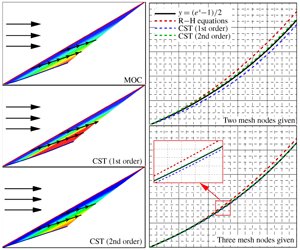Article contents
Second-order curved shock theory
Published online by Cambridge University Press: 27 March 2020
Abstract

Second-order curved shock theory is developed and applied to planar and axisymmetric curved shock flow fields. Explicit equations are given in an influence coefficient format, relating the second-order gradients of pre-shock and post-shock flow parameters to shock curvature gradients. Two types of applications are demonstrated. First, the post-shock flow fields behind known curved shocks are solved using the second-order curved shock equations. Compared with the first-order curved shock equations, the second-order equations give better agreement with solutions obtained using the method of characteristics. Second, the second-order theory is applied to capture the curved shock shape with limited flow field information. In terms of the residual sum of squares of the curved shock, the second-order curved shock equations give a value one order of magnitude better than those given by the Rankine–Hugoniot equations and the first-order equations. This improved accuracy makes the second-order theory a good candidate for solving shock capture problems in computational fluid dynamics algorithms.
- Type
- JFM Papers
- Information
- Copyright
- © The Author(s), 2020. Published by Cambridge University Press
References
- 11
- Cited by




